Abstract
The binding of estrogen to alpha-fetoprotein (AFP) in the plasma cannot account for the impaired estrogen response seen in immature rodents because estradiol (E2) doses that far exceed the total body burden of AFP will stimulate only modest uterine growth. We investigated this phenomenon in immature female mice by determining their uterine weights 23 hr after intraperitoneal injection of estrogens or AFP or both. Administration of either 0.5 micrograms of E2 or 10 ng of moxestrol (MOX) approximately doubled the uterine weight. Giving 1 microgram of AFP 1 hr before injection of either estrogen did not alter that response. Combining the E2 and AFP just prior to injection resulted in decreased uterine growth (34% inhibition). Preincubating the estrogens with purified AFP (0.1-50 micrograms) did not affect the growth response to moxestrol but markedly decreased the response to E2. This was not due to sequestering of hormone because maximal reduction of the E2 response (ca. 65% inhibition) required only 1.0 microgram of AFP (AFP/E2 molar ratio, 1:130), and higher AFP doses inhibited less. About 40% of the growth elicited by injection of either 0.5 micrograms of E2 or 10 ng of MOX was inhibited when these doses were preceded by injection of the preincubated AFP/E2 mixture but not when preceded by either of the components. In each experiment, the mitotic index of luminal epithelium was affected to the same degree as uterine weight. AFP and E2 incubated for 1 hr thus produce a potent inhibitor of estrogen-stimulated mitotic activity and growth. This inhibitor might act upon estrogen-responsive cells at specific sites at which competition by an inactive component of AFP can block the process.
Full text
PDF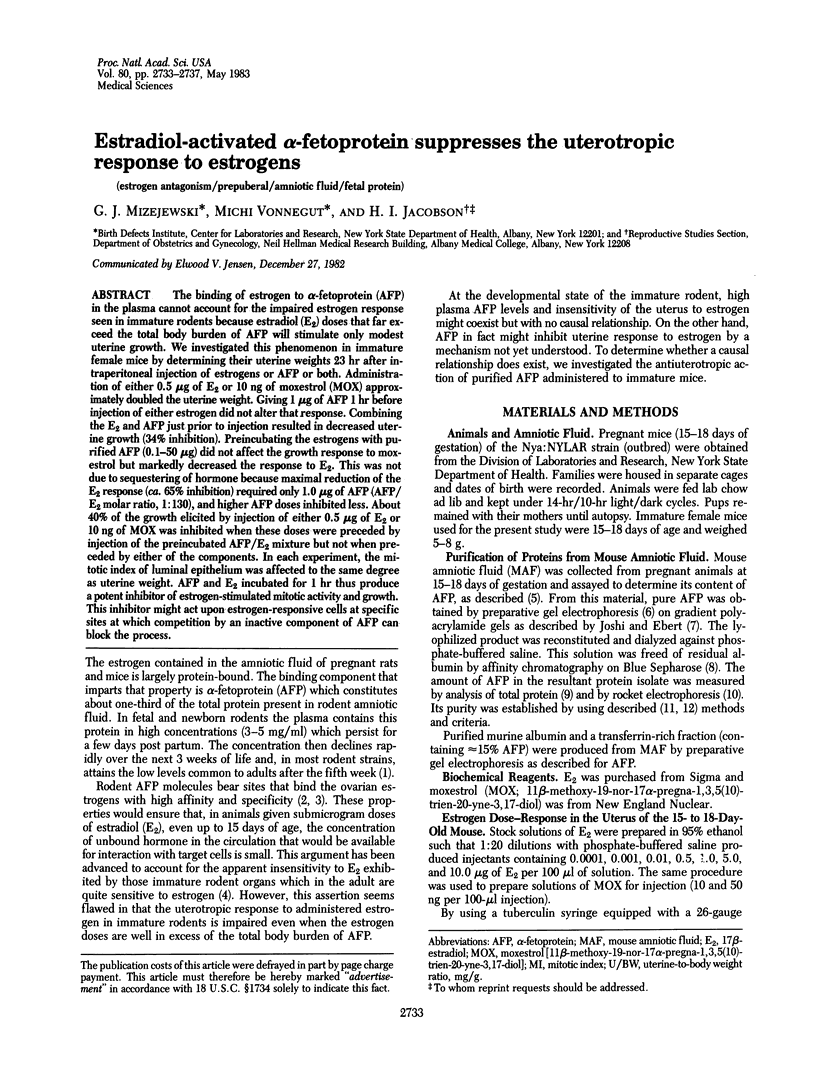
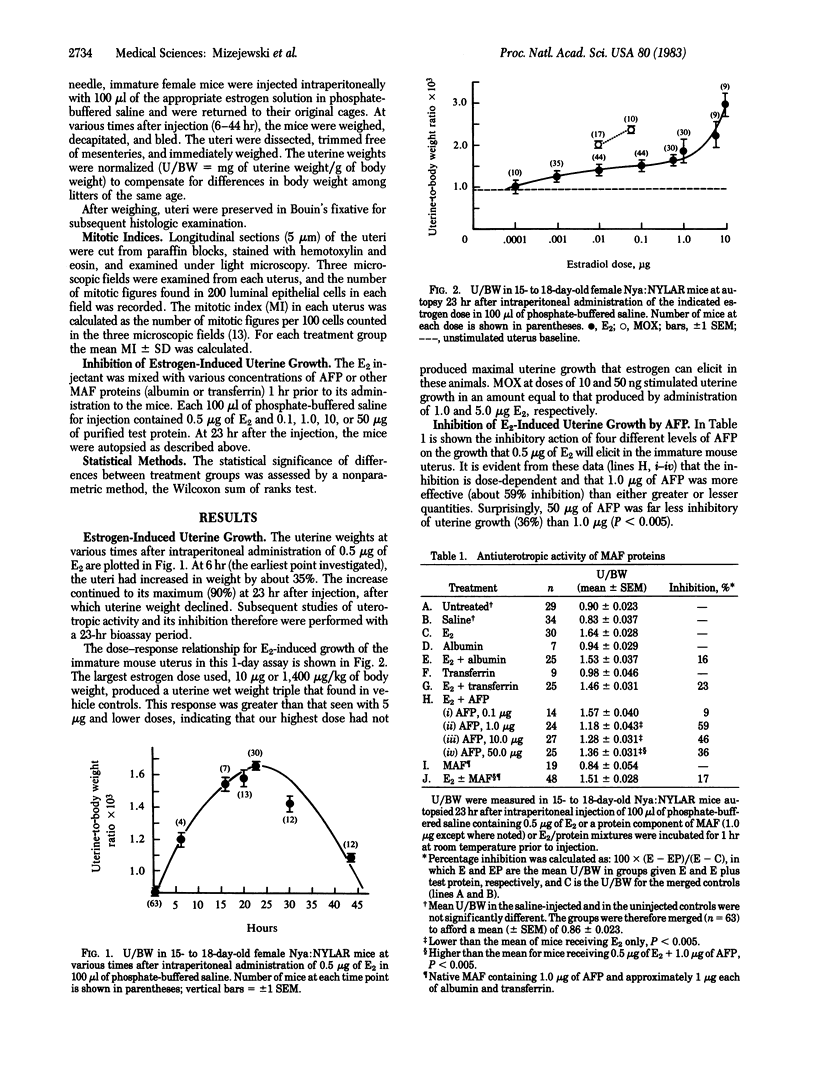
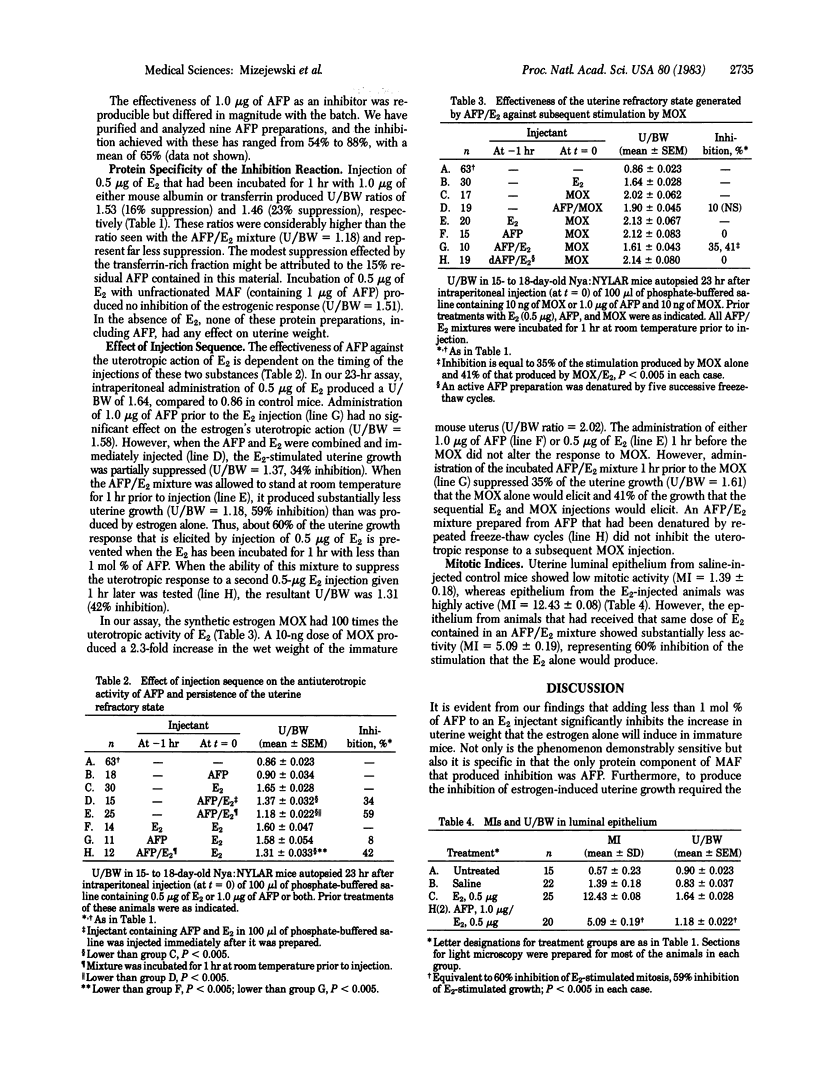
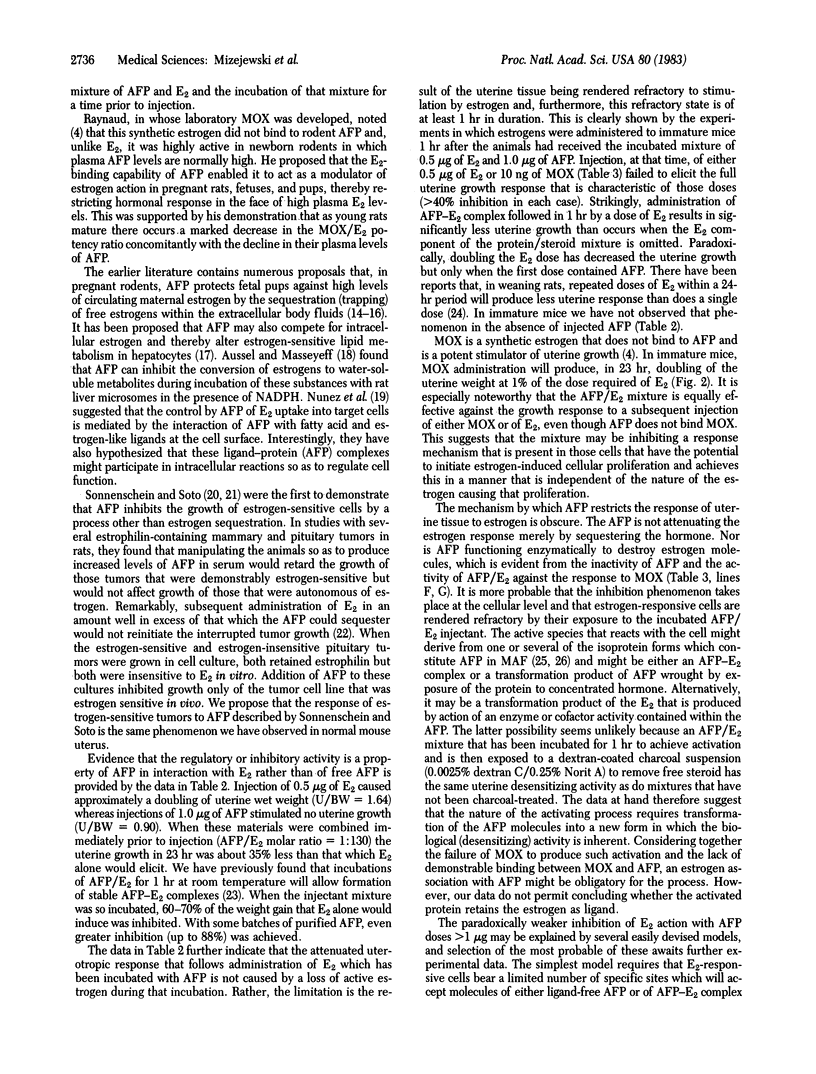
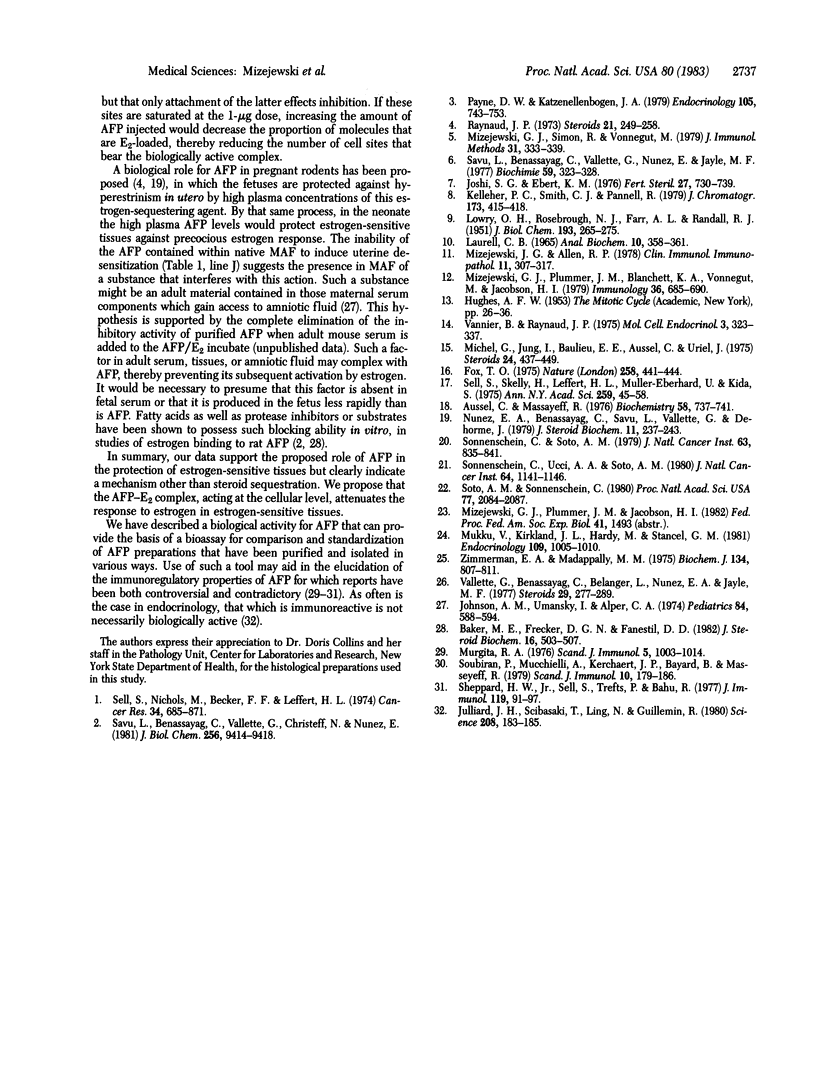
Selected References
These references are in PubMed. This may not be the complete list of references from this article.
- Aussel C., Masseyeff R. Alpha-foetoprotein and oestrogen metabolism. I. -Influence of alpha-foetoprotein on the metabolism of steroids by rat liver microsomes in vitro. Biochimie. 1976;58(6):737–741. doi: 10.1016/s0300-9084(76)80399-9. [DOI] [PubMed] [Google Scholar]
- Baker M. E., Frecker D. G., Fanestil D. D. Inhibition of estrogen binding to rat alpha-fetoprotein by tryptophan p-nitrophenyl esters. J Steroid Biochem. 1982 Apr;16(4):503–507. doi: 10.1016/0022-4731(82)90070-x. [DOI] [PubMed] [Google Scholar]
- Fox T. O. Oestradiol receptor of neonatal mouse brain. Nature. 1975 Dec 4;258(5534):441–444. doi: 10.1038/258441a0. [DOI] [PubMed] [Google Scholar]
- Johnson A. M., Umansky I., Alper C. A., Everett C., Greenspan G. Amniotic fluid proteins: maternal and fetal contributions. J Pediatr. 1974 Apr;84(4):588–593. doi: 10.1016/s0022-3476(74)80687-6. [DOI] [PubMed] [Google Scholar]
- Joshi S. G., Ebert K. M. Effects of progesterone on labeling of soluble proteins and glycoproteins in rabbit endometrium. Fertil Steril. 1976 Jun;27(6):730–739. doi: 10.1016/s0015-0282(16)41906-0. [DOI] [PubMed] [Google Scholar]
- Julliard J. H., Shibasaki T., Ling N., Guillemin R. High-molecular-weight immunoreactive beta-endorphin in extracts of human placenta is a fragment of immunoglobulin G. Science. 1980 Apr 11;208(4440):183–185. doi: 10.1126/science.6244620. [DOI] [PubMed] [Google Scholar]
- Kelleher P. C., Smith C. J., Pannell R. Chromatography of non-human albumins on Cibacron Blue-agarose. Application to the separation of albumin from rat alpha-fetoprotein. J Chromatogr. 1979 May 21;173(2):415–418. doi: 10.1016/s0021-9673(00)92314-8. [DOI] [PubMed] [Google Scholar]
- LAURELL C. B. ANTIGEN-ANTIBODY CROSSED ELECTROPHORESIS. Anal Biochem. 1965 Feb;10:358–361. doi: 10.1016/0003-2697(65)90278-2. [DOI] [PubMed] [Google Scholar]
- LOWRY O. H., ROSEBROUGH N. J., FARR A. L., RANDALL R. J. Protein measurement with the Folin phenol reagent. J Biol Chem. 1951 Nov;193(1):265–275. [PubMed] [Google Scholar]
- Michel G., Jung I., Baulieu E. E., Aussel C., Uriel J. Two high affinity estrogen binding proteins of different specificity in the immature rat uterus cytosol. Steroids. 1974 Oct;24(4):437–449. doi: 10.1016/0039-128x(74)90127-5. [DOI] [PubMed] [Google Scholar]
- Mizejewski G. J., Allen R. P. alpha-Fetoprotein: studies of tumor-associated antigen cytotoxicity in mouse hepatoma BW7756. Clin Immunol Immunopathol. 1978 Nov;11(3):307–317. doi: 10.1016/0090-1229(78)90055-7. [DOI] [PubMed] [Google Scholar]
- Mizejewski G. J., Plummer J. M., Blanchett K. A., Vonnegut M., Jacobson H. I. alpha-Foetoprotein:immunoreactivity of the major oestrogen-binding component in mouse amniotic fluid. Immunology. 1979 Apr;36(4):685–690. [PMC free article] [PubMed] [Google Scholar]
- Mizejewski G. J., Simon R., Vonnegut M. Purification of alpha-fetoprotein from mouse amniotic fluid by gel-entrapped antibody filtration. J Immunol Methods. 1979;31(3-4):333–339. doi: 10.1016/0022-1759(79)90146-7. [DOI] [PubMed] [Google Scholar]
- Mukku V. R., Kirkland J. L., Hardy M., Stancel G. M. Stimulatory and inhibitory effects of estrogen and antiestrogen on uterine cell division. Endocrinology. 1981 Oct;109(4):1005–1010. doi: 10.1210/endo-109-4-1005. [DOI] [PubMed] [Google Scholar]
- Murgita R. A. The immunosuppressive role of alpha-fetoprotein during pregnancy. Scand J Immunol. 1976;5(9):1003–1014. doi: 10.1111/j.1365-3083.1976.tb03052.x. [DOI] [PubMed] [Google Scholar]
- Nunez E. A., Benassayag C., Savu L., Vallette G., Delorme J. Oestrogen binding function of alpha 1-fetoprotein. J Steroid Biochem. 1979 Jul;11(1A):237–243. doi: 10.1016/0022-4731(79)90303-0. [DOI] [PubMed] [Google Scholar]
- Payne D. W., Katzenellenbogen J. A. Binding specificity of rat alpha-fetoprotein for a series of estrogen derivatives: studies using equilibrium and nonequilibrium binding techniques. Endocrinology. 1979 Sep;105(3):745–753. doi: 10.1210/endo-105-3-743. [DOI] [PubMed] [Google Scholar]
- Raynaud J. P. Influence of rat estradiol binding plasma protein (EBP) on uterotrophic activity. Steroids. 1973 Feb;21(2):249–258. doi: 10.1016/s0039-128x(73)80009-1. [DOI] [PubMed] [Google Scholar]
- Savu L., Benassayag C., Vallette G., Christeff N., Nunez E. Mouse alpha 1-fetoprotein and albumin. A comparison of their binding properties with estrogen and fatty acid ligands. J Biol Chem. 1981 Sep 25;256(18):9414–9418. [PubMed] [Google Scholar]
- Savu L., Benassayag C., Vallette G., Nunez E., Jayle M. F. Purification and estrogen binding properties of mouse alpha1-fetoprotein and of two forms of the protein with different affinities for concanavalin-A. Biochimie. 1977;59(3):323–328. doi: 10.1016/s0300-9084(77)80149-1. [DOI] [PubMed] [Google Scholar]
- Sell S., Nichols M., Becker F. F., Leffert H. L. Hepatocyte proliferation and alpha 1-fetoprotein in pregnant, neonatal, and partially hepatectomized rats. Cancer Res. 1974 Apr;34(4):865–871. [PubMed] [Google Scholar]
- Sell S., Skelly H., Leffert H. L., Muller-Eberhard U., Kida S. Relationship of the biosynthesis of alpha-fetoprotein, albumin, hemopexin, and haptoglobin to the growth state of fetal rat hepatocyte cultures. Ann N Y Acad Sci. 1975 Aug 22;259:45–58. doi: 10.1111/j.1749-6632.1975.tb25401.x. [DOI] [PubMed] [Google Scholar]
- Sheppard H. W., Jr, Sell S., Trefts P., Bahu R. Effects of alpha-fetoprotein on murine immune responses. I. Studies on mice. J Immunol. 1977 Jul;119(1):91–97. [PubMed] [Google Scholar]
- Sonnenschein C., Ucci A. A., Soto A. M. Age-dependent growth inhibition of estrogen-sensitive rat mammary tumors. Probable role of alpha-fetoprotein. J Natl Cancer Inst. 1980 May;64(5):1141–1146. [PubMed] [Google Scholar]
- Sonnenscheln C., Soto A. M. Growth inhibition of estrogen-sensitive tumor cells in newborn rats. Probable role of alpha-fetoprotein. J Natl Cancer Inst. 1979 Sep;63(3):835–841. doi: 10.1093/jnci/63.3.835. [DOI] [PubMed] [Google Scholar]
- Soto A. M., Sonnenschein C. Control of growth of estrogen-sensitive cells: role for alpha-fetoprotein. Proc Natl Acad Sci U S A. 1980 Apr;77(4):2084–2087. doi: 10.1073/pnas.77.4.2084. [DOI] [PMC free article] [PubMed] [Google Scholar]
- Soubiran P., Mucchielli A., Kerckaert J. P., Bayard B., Masseyeff R. Stimulatory effect of human alpha-fetoprotein and its molecular variants on in-vitro-induced lymphocyte blastogenesis. Scand J Immunol. 1979;10(2):179–186. doi: 10.1111/j.1365-3083.1979.tb03273.x. [DOI] [PubMed] [Google Scholar]
- Vallette G., Benassayag C., Belanger L., Nunez E. A., Jayle M. F. Rat iso-alpha1-fetoproteins. Purification and interaction with estradiol-17beta. Steroids. 1977 Feb;29(2):277–289. doi: 10.1016/0039-128x(77)90046-0. [DOI] [PubMed] [Google Scholar]
- Vannier B., Raynaud J. P. Effect of estrogen plasma binding on sexual differentiation of the rat fetus. Mol Cell Endocrinol. 1975 Nov;3(5):323–337. doi: 10.1016/0303-7207(75)90034-9. [DOI] [PubMed] [Google Scholar]
- Zimmerman E. F., Madappally M. M. Sialyltransferase: regulation of alpha-foetoprotein microheterogeneity during development. Biochem J. 1973 Jul;134(3):807–810. doi: 10.1042/bj1340807. [DOI] [PMC free article] [PubMed] [Google Scholar]


